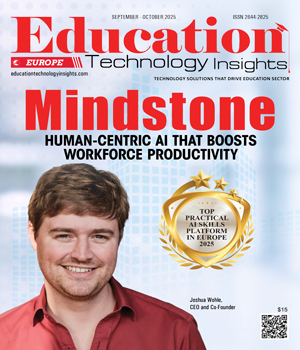THANK YOU FOR SUBSCRIBING
Be first to read the latest tech news, Industry Leader's Insights, and CIO interviews of medium and large enterprises exclusively from Education Technology Insights
AI Is Big - Will Quantum Be Bigger?
Brendan McGinty, Director of Industry, National Center for Supercomputing Applications (NCSA), University of Illinois, Urbana-Champaign
 Brendan McGinty, Director of Industry, National Center for Supercomputing Applications (NCSA), University of Illinois, Urbana-Champaign
Brendan McGinty, Director of Industry, National Center for Supercomputing Applications (NCSA), University of Illinois, Urbana-ChampaignThe rise of artificial intelligence (AI) has been truly revolutionary. In just the past several years, AI has permeated industries from finance and healthcare to agriculture and entertainment. AI now diagnoses diseases, detects cyber threats, and drives cars. It has become the symbol of the Fourth Industrial Revolution. But as AI continues to reshape our world, a new technological frontier is building momentum: quantum computing. The question now facing scientists, educators, and industry leaders alike is: AI is big, but will quantum be bigger?
To answer that, we need to understand what quantum computing is and how it differs from classical computing. While classical computers rely on bits – binary 0s and 1s – quantum computers operate using qubits, which can exist in superpositions of states. This allows quantum machines to perform certain calculations exponentially faster than classical computers. Tasks that would take months or years on today’s fastest supercomputers might one day be solved in seconds with quantum processors. For problems involving optimization, simulation, and complex data structures, quantum computing holds transformative potential.
The AI revolution was driven by the confluence of data, algorithms, and computing power. It rode the exponential wave of Moore’s Law and benefited from open-source collaboration, venture investment, and widespread digital infrastructure. By contrast, quantum computing remains in its infancy, akin to where AI was in the early 2000s, though the funding is really starting to flow for quantum competitors. Quantum machines today are highly sensitive, error-prone, and limited in scale. Still, breakthroughs by companies like IBM and Google and startups like Rigetti and IonQ suggest that we're moving steadily from quantum curiosity to quantum utility quicker than even experts previously predicted.
“Quantum will likely follow suit, opening new career pathways and redefining what technical literacy means in the coming decades”
So, will quantum outshine AI? The comparison isn't entirely apples to apples. AI is a technology with broad purposes that has reshaped nearly every corner of the economy. Quantum computing, at least initially, appears to be highly specialized—most valuable for certain types of problems where classical systems hit hard limits. However, the synergy between AI and quantum may be where the true disruptive power lies. Quantum machine learning, for example, promises faster training of complex models and novel approaches to pattern recognition and optimization. In this sense, quantum might not replace AI but supercharge it.
The implications for education and workforce development are profound. The AI boom already transformed curricula across universities. Today, coding, data science, and algorithmic thinking are as fundamental as calculus. With quantum computing on the horizon, a similar evolution is needed. Institutions must start integrating quantum concepts—like superposition, entanglement, and quantum gates—into computer science and engineering programs. Already, initiatives like the NSF’s Quantum Leap Challenge Institutes and IBM’s Qiskit platform are helping students and educators get hands-on with quantum concepts.
Quantum computing will also demand interdisciplinary knowledge and collaboration. A successful quantum team won’t just consist of physicists and computer scientists. It will require a blend of mathematics, engineering, material science, and even ethics and policy. This mirrors the path AI took, evolving from a niche discipline to a broad ecosystem of roles—data scientists, machine learning engineers, AI ethicists, and AI product managers. Quantum will likely follow suit, opening new career pathways and redefining what technical literacy means in the coming decades.
Yet, challenges abound. The steep learning curve of quantum mechanics, the lack of widespread educational materials, and the current limitations in hardware all slow broader adoption. There is also the risk of a hype cycle, where expectations outpace reality, potentially leading to disillusionment. Managing this requires not only sustained investment in R&D but also transparent communication about what quantum can and cannot do—at least in the near term.
Ultimately, while AI has already transformed our world, quantum computing is still setting the stage. But if its promise holds, quantum could indeed be bigger, perhaps not in reach, but in depth. It may not touch every industry like AI, but where it does land, in drug discovery, logistics, finance, and climate modeling, among others, it could spark revolutions of its own. In the coming years, we won’t be asking whether quantum computing will replace AI. Instead, we’ll be exploring how the two can work in tandem to unlock problems that were once beyond imagination. For stakeholders, including researchers, students, educators, and others, this is a challenge and an invitation to prepare not just for today’s digital world but for a quantum one that is rapidly coming into view.
Read Also
Zombies, Wizards and Superheroes
Reframing Academic Integrity in an AI-World
Step into The Future: How Inspired's Metaverse is Transforming Learning
Nurturing our Future Learners - The Spark that ignites Creativity
Balancing Human Connection and Technology for Impact
Applied Microcredentials for Opportune Upskilling in Aquaculture

I agree We use cookies on this website to enhance your user experience. By clicking any link on this page you are giving your consent for us to set cookies. More info

However, if you would like to share the information in this article, you may use the link below:
www.educationtechnologyinsightseurope.com/cxoinsights/brendan-mcginty-nid-3194.html






















